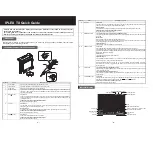
7 of 16
The entire suspension system and fin assembly can be moved aft to the second set of holes
in the Orca Bracket if more length is desired to give the fin a little more leverage to the fin.
Pre-Dive Checkout:
Before each use, visually inspect your DOL-Fin for damage and/or loose hardware. Never
use a DOL-Fin that has loose hardware or shows signs of structural damage or cracking.
A small fatigue crack can propogate quickly and result in a potentially catistrophic part
failure during a dive. One of the great benefits of your DOL-Fin is its modular design that
makes part repairs and replacement very easy to perform. So, if a visual inspection shows
that something on your fin is loose, broken or compromised, don’t just dive it as is;
fix it!
Inspection Checklist:
(1)
Check the hardware. Make sure that all the nuts are appropriately tightened and
that the nut locking mechanisms are properly engaging the screw threads such that
none of the hardware can come apart during use. Visually inspect the hardware for
corrosion. Replace any screws, nuts or washers that show signs of weakening.
(2)
Visually inspect the aluminum structural parts for damage from fatigue, cracking or
corrosion. Cracked structural components must be replaced.
(3)
Visually inspect the suspension straps and suspension guides for cuts, cracks or
signs of weakening. The suspension action should be pliable and responsive.
Replace any suspension componants that show damage or that seem degraded, as
that can diminish the DOL-Fin’s performance.
(4)
Check that the Foot Binding Straps are in good shape and that the shoe’s Velcro
straps have adequate holding strength.
(5)
Extend the fin tip bungees to visually inspect the fasteners and materials of the
bungee assembly for wear or broken parts. Insert the fin tips into the foil ends in
swimming configuration, and inspect them for desired shape, curvature and twist.
If necessary, massage the fin tips with the hands until they hold the desired shape.
Use and Operation:
Your DOL-Fin is a revolutionary swimmer propulsion device and works differently from
traditional swimming fins. It is important that you read this section before using your new
DOL-Fin.
8 of 16
The Orca2 monofin is designed to be used with dive socks. To provide the maximum
level of energy transfer to the monofin, the straps do not have any padding attached to
them and instead rely on padding worn on the foot to eliminate chaffing of the straps on
the foot. If a dive sock is not available, a cotton gym sock will do almost as well. The
more padding between the foot and the strap, the more movement is possible and the less
connected the foot will be to the fin. So, adding strap padding on top of the dive sock
would be counterproductive and it was therefore not included.
YouTube video (
http://youtu.be/Mpwvsch6hQk
) shows some useful information on how to
adjust the binding straps to get a good fit for your feet. If diving with thick dive socks,
you can often get a better connection with the Orca2 by diving down about 6 to 7 meters
and pulling the heel straps again to snug your feet into the binding straps while the dive
socks are compressed.
Selecting a Trim Setting for the DOL-Fin:
The DOL-Fin can be configured with different settings for the lateral fin’s suspension
system through the use of different suspension guides and the mounting holes selected.
These suspension guides modify the rotation range of the fin relative to the frame and the
different mounting options modify the length of the lever arm to the fin. Changing these
settings affect the dynamics of the hydrofoil and the overall thrust and feel of the fin.
Your DOL-Fin can essentially become many different monofins through selection and use
of different trim options.
Start with the short arm configuration and the shorter stock length top suspension guides.
If you feel like you want more thrust from the downstroke relative to the upstroke, you can
replace the top suspension guide with a longer suspension guide that will produce a higher
angle-of-attack of the fin blade during the down stroke, resulting in more thrust. Then try
moving the entire fin and suspension system assembly to the aft set of mounting holes to
configure the fin on the longer arm and see if you like that setting better or worse. Select
the combination that feels best to you. In general, a longer top suspension guide will
provide both more thrust and more resistance on the fin’s down stroke, whereas the
extended suspension/fin mounting will provide more thrust and more resistance on both of
the fin’s strokes. As the top and bottom suspension guide parts are the same parts trimmed
to different lengths, it is easy to make a custom length top guide by trimming the part for a


























